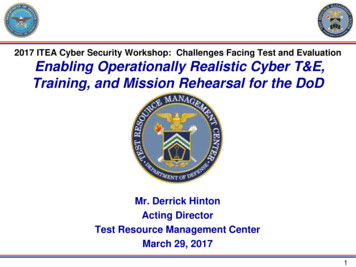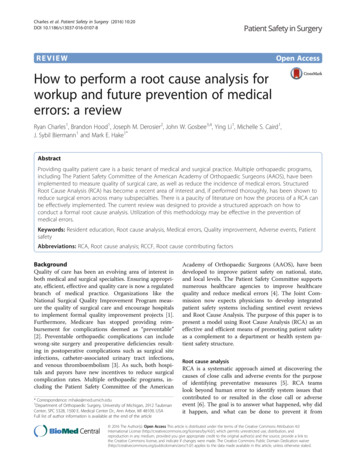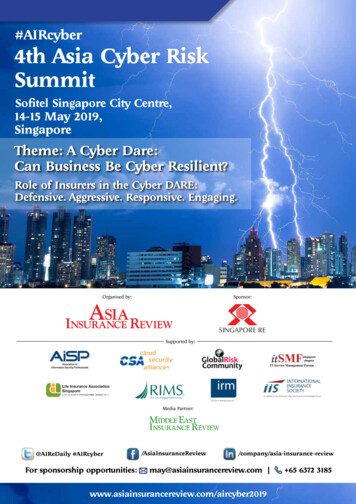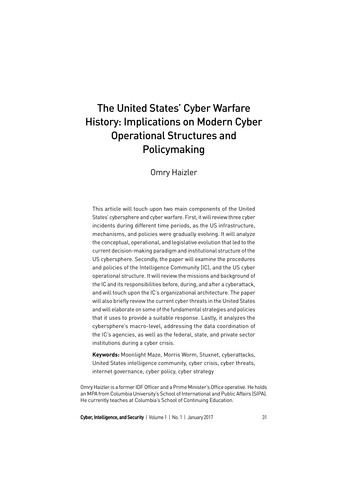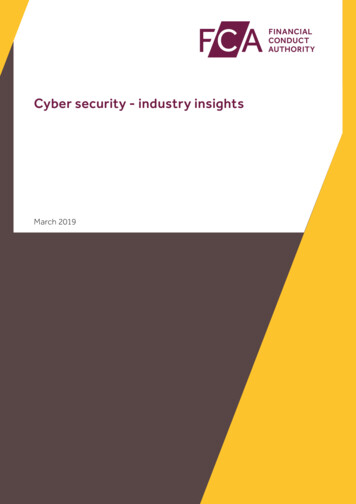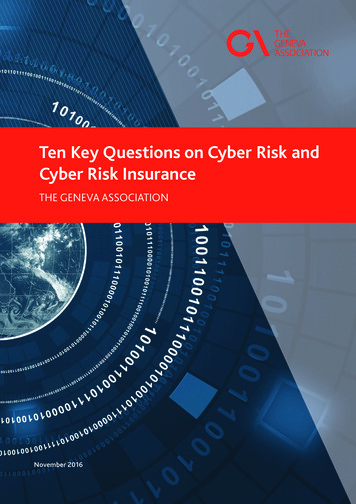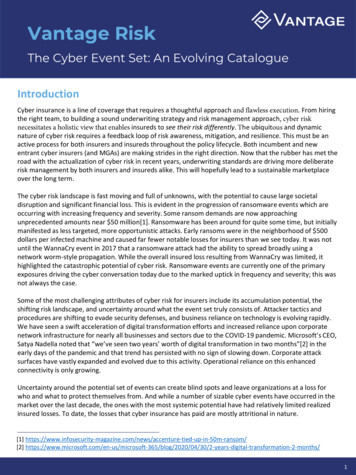
Transcription
Vantage RiskThe Cyber Event Set: An Evolving CatalogueIntroductionCyber insurance is a line of coverage that requires a thoughtful approach and flawless execution. From hiringthe right team, to building a sound underwriting strategy and risk management approach, cyber risknecessitates a holistic view that enables insureds to see their risk differently. The ubiquitous and dynamicnature of cyber risk requires a feedback loop of risk awareness, mitigation, and resilience. This must be anactive process for both insurers and insureds throughout the policy lifecycle. Both incumbent and newentrant cyber insurers (and MGAs) are making strides in the right direction. Now that the rubber has met theroad with the actualization of cyber risk in recent years, underwriting standards are driving more deliberaterisk management by both insurers and insureds alike. This will hopefully lead to a sustainable marketplaceover the long term.The cyber risk landscape is fast moving and full of unknowns, with the potential to cause large societaldisruption and significant financial loss. This is evident in the progression of ransomware events which areoccurring with increasing frequency and severity. Some ransom demands are now approachingunprecedented amounts near 50 million[1]. Ransomware has been around for quite some time, but initiallymanifested as less targeted, more opportunistic attacks. Early ransoms were in the neighborhood of 500dollars per infected machine and caused far fewer notable losses for insurers than we see today. It was notuntil the WannaCry event in 2017 that a ransomware attack had the ability to spread broadly using anetwork worm-style propagation. While the overall insured loss resulting from WannaCry was limited, ithighlighted the catastrophic potential of cyber risk. Ransomware events are currently one of the primaryexposures driving the cyber conversation today due to the marked uptick in frequency and severity; this wasnot always the case.Some of the most challenging attributes of cyber risk for insurers include its accumulation potential, theshifting risk landscape, and uncertainty around what the event set truly consists of. Attacker tactics andprocedures are shifting to evade security defenses, and business reliance on technology is evolving rapidly.We have seen a swift acceleration of digital transformation efforts and increased reliance upon corporatenetwork infrastructure for nearly all businesses and sectors due to the COVID-19 pandemic. Microsoft’s CEO,Satya Nadella noted that “we’ve seen two years’ worth of digital transformation in two months”[2] in theearly days of the pandemic and that trend has persisted with no sign of slowing down. Corporate attacksurfaces have vastly expanded and evolved due to this activity. Operational reliance on this enhancedconnectivity is only growing.Uncertainty around the potential set of events can create blind spots and leave organizations at a loss forwho and what to protect themselves from. And while a number of sizable cyber events have occurred in themarket over the last decade, the ones with the most systemic potential have had relatively limited realizedinsured losses. To date, the losses that cyber insurance has paid are mostly attritional in nature.[1] re-tied-up-in-50m-ransom/[2] s/1
Vantage RiskThe Cyber Event Set: An Evolving CatalogueLast year, the NAIC reported that the top 20 groups in the cyber insurance market had 2020 direct loss ratiosranging from 24% to 114.1% with an average of 66.9% (up from 44.6% in 2019)[3]. These figures beg thequestion of whether catastrophe losses are being adequately accounted for in carrier pricing strategies giventhis loss year did not include a major cyber catastrophe.So, what does the cyber event set look like? When considering this, insurers and insureds alike are probablyasking themselves, “Where’s the cat? And what’s in the tail?”The Cyber Event SetThe below is meant to serve as a primer highlighting some types of cyber events that organizations and theirinsurers should be thinking about. This list is in no way comprehensive but meant to outline some of thebroad categories and provide real-world examples that have been observed.Data BreachCyber insurance’s initial uptake was largely driven by data breach notification laws. These laws place strictobligations on corporations to notify individuals if their private information has been exposed. The first ofthese laws was inked in California in 2002; now nearly every US state has a similar law, and Europe has theGeneral Data Protection Regulation (GDPR). Data breaches come with immediate first-party costs for advisorsand providers to isolate, identify, and remediate the affected systems. In addition to notifying individuals, ithas become customary to offer credit monitoring to affected individuals as well. Depending upon thecircumstances, corporations can face liability, fines, and penalties for a data breach as well. Finally, thebusiness interruption, reputational blow, and loss of customer trust often leads to reduced sales for someamount of time.Some notable data breaches include: Target Corporation’s 2013 breach of 40 million customer credit cards via BlackPOS which siphonedunencrypted credit-card transactions in transit and exfiltrated the data without detection. A notable earlyloss that cost the company approximately 290 million of which only 90 million was insured[4]. US Office of Personnel Management’s 2015 breach which exposed over 4 million individuals backgroundinvestigation records[5]. Yahoo’s 2017 data breach of 3 billion accounts which negatively impacted acquisition negotiations withVerizon to the tune of 350 million[6]. First American Financial’s 2019 breach of 885 million customers’ financial information including bankaccount information, social security numbers, wire transactions and mortgage details[7].[3] -cmte-c-Cyber Supplement 2020 Report.pdf[4] anks-over-databreach-idUSKBN0TL20Y20151203[5] cidents/[6] o-hack-3-billion-users.html[7] leak-how-did-ithappen-and-what-does-it-mean/?sh 24cce637567f2
Vantage RiskThe Cyber Event Set: An Evolving CatalogueRansomwareIf data breaches drove the first wave of cyber insurance, then the second wave has certainly been dominatedby the dramatic shift in the ransomware landscape. Ransomware deploys malicious code onto a system,encrypts the machine’s contents so they cannot be accessed by the user, and demands a ransom payment,typically in cryptocurrency, to decrypt the data. Surprisingly, there is honor among thieves; though there is noguarantee, cyber criminals typically make good on decryption when the ransom is paid. Some groups areeven known to have decent customer service helping victims through the process.Ransomware is a much more direct monetization scheme for bad actors than stealing data. In the data breachera, cybercriminals would monetize their efforts by selling the stolen data on the dark web where othercriminals leverage the information to commit fraud and steal identities. In contrast, ransomware simplifiesthe process and tightens the connection between delivering the payload and monetization, and has becomethe attack du jour. In addition to the direct loss due to the ransom, organizations will typically suffer firstparty losses for remediation, business interruption, and potential data breach related costs as well.Some recent individual company ransomware events include: CNA’s 2021 ransomware which led to a 40 million ransom payment and exposed 75,000 personal recordsincluding social security numbers[8]. Colonial Pipeline’s 2021 ransomware attack, which caused the operators to shut down an entire pipelinewhich normally transports 2.5 million barrels of oil per day. This was the first full scale shut-down in its 57year history. The company paid 4.4 million ransom and lost nearly 100 gigabytes of data. Additionally, gasshortages due to the outage caused price increases[9].Targeted data breaches and ransomware payloads are often delivered via phishing and spear-phishing attacksrather than complex brute force hacking of a network. Manipulative emails and social media activity are usedto dupe well intentioned employees into clicking on malicious files and links thus creating an entry point forattackers.Widespread EventsMany of the events noted thus far are targeted and impact one company at a time. However, theinterconnectivity of the internet and commonality of software, hardware, and service provider usage createsthe potential for risk correlations which can lead to cyber catastrophe events with accumulation losses.Zero Day VulnerabilitiesZero-day vulnerabilities are security flaws that a software vendor has not yet created a patch for due to eithernot knowing of the vulnerability yet or because it has only recently been discovered. Upon discovery,attackers will scour the internet for vulnerable systems to exploit, resulting in the potential for aggregatedlosses in the period before a patch is released and broadly adopted.[8] 2jle5opb65hczlpz6tifik6n2a-story.html[9] sedpassword3
Vantage RiskThe Cyber Event Set: An Evolving CatalogueSome notable zero-day vulnerabilities include: The ‘ShadowBrokers’ hacker group disclosed the EternalBlue zero-day vulnerability for Windows in 2017which was leveraged by both the Wannacry and NotPetya ransomware attacks. These attacks enlisted aworm propagation method to infect large numbers of corporate machines across the world. Claimsemanating from these events have tested the policy language on cyber and non-cyber policies, sparkingindustry debate about intent and coverage litigation. The US White House estimated the total economicdamages from NotPetya to be approximately 10 billion, an unprecedented single-event ransomwareloss[10]. Solarwinds Orion software is used to help manage network infrastructure for public and private sectorentities. In 2020, Hackers inserted malicious code into legitimate software updates, leveraging a backdoorto infect Solarwinds Orion customers and providing broad access to their networks. In an SEC filing,Solarwinds stated that fewer than 18,000 of 33,000 Orion customers were affected[11]. A Russianadvanced persistent threat group named Cozy Bear was reported to be behind these attacks, impactingnotable targets including The US Treasury, The US Department of Homeland Security, and cybersecurityfirm FireEye (now Trellix)[12]. In early 2021, four zero-day vulnerabilities were discovered which, when used together, enabled remotecode execution in Microsoft Exchange servers. Microsoft exchange servers are widely used for businessemail and calendars across the globe, so the scope of vulnerable machines was quite broad. Attacksleveraging the vulnerabilities have been linked to several state-sponsored advanced persistent threatgroups. According to CNN, approximately 30,000 US companies and 250,000 companies globally wereimpacted[13]. Kaseya offers IT software that enables remote monitoring and management of network endpoints.Customers include Managed Service Providers (MSPs) who offer security and IT services as a provider tomany companies. In 2021, a supply chain attack was launched impacting MSPs using the Kaseya softwareand their customers resulting in between 800-1500 successful ransomware attacks[14]. Log4J is a zero-day vulnerability discovered in late 2021 which enables remote code execution in the Javalogging framework that is widely used across the internet. Although potentially broad in scope, thus farthe known impact has been limited with some insurers citing the difficulty in exploiting the vulnerability asthe saving grace which has limited ultimate impact for their insureds[15].These examples highlight how differences in exploitability, severity, and usage can have widely varyingoutcomes. There are many other notable zero-day vulnerabilities that have occurred, but this provides a goodset of examples to draw from.[10] kraine-russia-code-crashed-the-world/[11] https://www.sec.gov/ix?doc i-20201214.htm[12] ed-bycozy-bear-hackers/[13] ange-hafnium-hack-explainer/index.html[14] -globaldisruption-to-customers/[15] posure/4
Vantage RiskThe Cyber Event Set: An Evolving CatalogueService Provider AttacksThe proliferation of cloud computing has intentionally aggregated companies to shared computing andstorage resources, bringing many benefits and efficiencies to business users. However, service provideraggregations like this create circumstances that drive correlated risk across companies. To date, most outageshave been regional and relatively short, but looking at the limited outages which have been realized througha counter-factual lens shows that circumstances can certainly escalate to higher severities than we have seento date, at least in the tail. Cloud service providers like Amazon AWS are, by-and-large very reliable, butoutages affecting even a subset of a cloud provider’s network can impact the many companies who rely onthat portion of shared infrastructure. US East 1 is Amazon AWS’s largest set of data centers. It is currentlycomprised of 6 availability zones (us-east-1a through 1f). When contracting with a cloud provider, companiescan specify which availability zones the infrastructure they are leveraging is located in and can purchaseaccess to additional availability zones for redundancy in case of an outage. Other leading providers such asGoogle Cloud Platform and Microsoft Azure offer similar redundancy configuration options. In 2016, domain name service (DNS) provider, Dyn, suffered a significant distributed denial-of-serviceattack (DDoS), bringing down major internet platforms including Amazon, Netflix, The New York Times,Reddit, Slack, Twitter, among others[16]. DDoS attacks flood servers with requests in an attempt todegrade performance and cause a failure of the servers due to the overload of requests. This attack wasachieved by flooding Dyn’s DNS servers with requests from tens of millions of IP addresses. DNS serverstypically provide the IP addresses associated to a website, serving as a phonebook for users of webbrowsers looking up a URL and routing them to the associated IP address. This attack was achieved via abotnet of zombie printers, camera, cable boxes, and other personal connected devices which had beeninfected by and controlled via the Mirai malware and botnet servers. Botnets are networks of infectedmachines that are controlled as a group by the botnet’s operator unbeknownst to the actual owners of theinfected machines. The Mirai botnet was first seen a month prior when it delivered a DDoS attack ofunprecedented intensity reaching 620 Gbit/s and bringing down investigative journalist Brian Krebs’website[17]. Amazon AWS has had an incredible record of reliability and overall uptime, but has suffered a number ofnotable outages over the years. To their credit, Amazon is incredibly transparent and thorough in theirreporting of the details of each of their outage events. In 2017 the S3 service suffered a four-hour outageaffecting the US East 1 region due to a human error during a system update[18]. In 2020 Amazon’s Kinesisservice was disrupted for over twelve hours in the US East 1 region[19] impacting several companies usingthe service including Ring, Roku, Adobe, Target, and the NYC MTA[20]. Most recently, AWS suffered aseven-hour outage in 2021 in US East 1 region[21] which impacted Amazon’s delivery operations andWhole Foods orders along with impacting third party services including Disney , Netflix, Slack,Ticketmaster, Coinbase, and a number of universities[22].[16] ding-twitter-and-spotify-suffering-outage/[17] y-hit-with-record-ddos/[18] https://aws.amazon.com/message/41926/[19] https://aws.amazon.com/message/11201/5
Vantage RiskThe Cyber Event Set: An Evolving CatalogueWhile zero-day vulnerabilities have very broad potential impact, there is a high likelihood that a givenvulnerable company is not impacted just by chance. However, outages at a service provider will definitivelyimpact any users reliant upon the affected shared infrastructure, unless they have built redundancy into theirtechnology stack that can be switched over when needed.Physical Cyber EventsThe above examples have all been purely digital in nature. While the Colonial Pipeline ransomware exampleresulted in the pipeline being shut down, this was done voluntarily out of caution given the potential risk anduncertainty around the attacker’s identity and motivations. But cyber events can also directly impact thephysical world. Several attacks have impacted industrial control systems resulting in direct physicalconsequences.A few notable examples include: In 2010, the Stuxnet malware was discovered in the wild with a disproportionate number of infectionslocated in Iran. The worm spreads indiscriminately causing no affect to most infected systems. Themalware also carries a payload that targets Siemens SCADA systems which control uranium enrichmentprocesses in Iran. Stuxnet leveraged multiple zero-day vulnerabilities and is said to be the mostsophisticated malware ever seen[23]. This attack highlighted that even air-gapped systems, which are notconnected to the internet in any direct or indirect manner, are not imperviable; the virus was spread viaUSB sticks and successfully disrupted nuclear enrichment equipment and processes[24]. In 2015, a cyber-attack on the Ukrainian power grid resulted in power outages affecting approximately225,000 citizens. The attack was the first publicly acknowledged successful cyberattack on a power gridand was attributed to a Russian state-sponsored advanced persistent threat group called Sandworm[25].While the severity of this event was relatively mild, it serves as a proof of concept of what is possible of acyberattack targeted at critical infrastructure. In 2019, Norsk Hydro, an aluminum and renewable energy company, fell victim to an extensive cyberattack involving the LockerGoga ransomware which cost approximately 70 Million. Norsk Hydro decidednot to pay the ransom demands and remediated their network themselves. Unlike Colonial Pipeline’svoluntary decision to shut down the pipeline’s operations out of caution, Norsk Hydro’s disruption inproduction was not by choice as the impacted systems were directly involved in the company’s automatedmanufacturing processes[26,27].[20] s-outage-takes-some-services-offline.html[21] https://aws.amazon.com/message/12721/[22] html[23] systems.html[24] iranian-nuclear-plant-on-thumb-drive/[25] ploads/sites/43/2016/05/20081514/EISAC SANS Ukraine DUC 5.pdf[26] tack/[27] dro6
Vantage RiskThe Cyber Event Set: An Evolving CatalogueAs the geopolitical landscape becomes more precarious, physical cyber-attacks become a more likely tool tobe utilized independently or as part of a multi-pronged act of hostility. Warring nations could leverage acyber-attack on critical infrastructure to further destabilize their adversary in tandem with more traditionalwarlike activities. The underwriting community has been striving for greater clarity on their coverage intentaround cyber risks for a number of years; many traditional P&C policies were written at a time when cyberexposures were not top of mind and the contractual language remained silent, not clearly addressingwhether there was or wasn’t coverage afforded under the policy. The Lloyds Market Association and severallarge international carriers have made public commitments to either affirmatively cover or exclude cyberexposures on their policies[28]; this contract certainty and transparency is beneficial to (re)insurers, brokers,and insureds.ConclusionThis paper is meant to serve as a primer for cyber risk, establishing a foundation by identifying the primaryexposures in the event set. The risk landscape will continue to evolve and (re)insurance carriers will play anincreasingly critical role in the cyber risk ecosystem. Insurers are in a unique position to help their insuredsbetter understand their exposures, adapt their processes and technology, and drive resilient behaviors whichmitigate loss potential. Ultimately, these interactions promote a more sustainable cyber insurance marketthat functions to efficiently reduce and transfer risk.[28] %20for%20cyber%20exposures.pdf7
About the AuthorPhil Rosace is VP, Data Asset Lead at VantageRisk.Phil has spent the last 12 years working inthe insurance and insurtech industry. He hasheld product and market facing cyberunderwriting, and analytics roles at leadingcarriers. Phil has also served technologyproduct management, solution architect, andsales and marketing roles at leading earlystage and mature insurtech companiesincluding Cyence (6th employee), Guidewire,and Two Sigma IQ. He is an inventor on acyber risk quantification patent. Phil holds amaster’s degree and bachelor’s degree, bothin economics from Boston University.This material is provided for informational purposes only.It is not intended as, nor does it constitute, legal, technicalor other professional advice. While reasonable attemptshave been made to ensure that this information isaccurate and current as of its publication date, Vantage isnot responsible for any errors or omissions and makes noguarantees, representations or warranties, either expressor implied, as to the accuracy, completeness or adequacyof any information contained herein. Additionally, thismaterial does not address all potential risks and maycontain time-sensitive information. Vantage is under noobligation, and expressly disclaims any obligation, toupdate or revise this material. This material may not bereproduced or distributed without the express, writtenpermission of Vantage Group Holdings Ltd. 2022 Vantage Group Holdings Ltd. All rights reserved.8
Cyber insurance is a line of coverage that requires a thoughtful approach and flawless execution. From hiring . The company paid 4.4 million ransom and lost nearly 100 gigabytes of data. Additionally, gas . The US Department of Homeland Security, and cybersecurity firm FireEye (now Trellix)[12]. .




